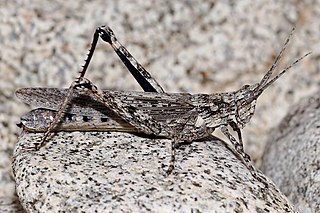
Acrididae are the predominant family of grasshoppers, comprising some 10,000 of the 11,000 species of the entire suborder Caelifera. The Acrididae are best known because all locusts are of the Acrididae. The subfamily Oedipodinae is sometimes classified as a distinct family Oedipodidae in the superfamily Acridoidea. Acrididae grasshoppers are characterized by relatively short and stout antennae, and tympana on the side of the first abdominal segment.
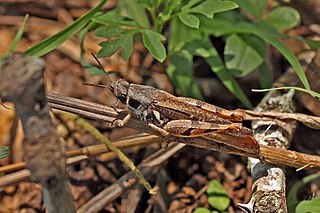
The subfamily Catantopinae is a group of insects classified under family Acrididae. Genera such as Macrotona may sometimes called "spur-throated grasshoppers", but that name is also used for grasshoppers from other subfamilies, including the genus Melanoplus from the Melanoplinae.

Bandwings, or band-winged grasshoppers, are the subfamily Oedipodinae of grasshoppers classified under the family Acrididae. They have a worldwide distribution and were originally elevated to full family status as the Oedipodidae. Many species primarily inhabit xeric weedy fields, and some are considered to be important locusts:

The Calliptaminae are a subfamily of grasshoppers containing species found in Africa, Europe and Asia; some are economically important. It was originally erected as a tribe by G.G. Jacobson in 1905 as the "Calliptamini", later uprated by Dirsh in 1956.

The African rice grasshopper, Hieroglyphus daganensis is a medium-sized grasshopper species found in the Sahel region. Although not called a locust in English, this species shows gregarious behaviour and some morphological change on crowding and may become a moderately important pest species for small-holder farmers in the region.

Calephorus compressicornis is a species of grasshopper in the tribe Calephorini found in Europe and Africa.

Catantops is a genus of grasshoppers in the tribe Catantopini and is typical of the subfamily Catantopinae. Species can be found in Africa, including Madagascar and subcontinental India.
Cryptocatantops debilis is a species of grasshoppers in the subfamily Catantopinae, a group of insects commonly called spur-throated grasshoppers. The type specimen was a female found in Omaruru, Namibia.

The Lentulidae are a family of flightless grasshoppers found in sub-Saharan Africa.
The Lithidiidae are a family of grasshoppers, in the Orthoptera: suborder Caelifera. Species in this family can be found in Africa.

The Hemiacridinae are a subfamily of Acrididae in the Orthoptera: Caelifera. Species can be found in Africa and Asia.
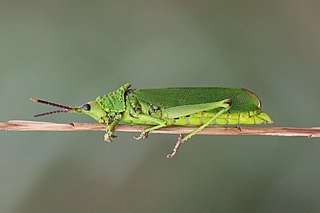
The Pyrgomorphinae are a subfamily of grasshoppers in the family Pyrgomorphidae. Species are found in, predominantly in the warmer regions of: Central and South America, southern Europe, Africa, Asia, Australia and Pacific Islands. The type genus is Pyrgomorpha and names dates from "Pyrgomorphiden" by Brunner von Wattenwyl, 1874. The first use of Pyrgomorphinae was by Krauss in 1890.
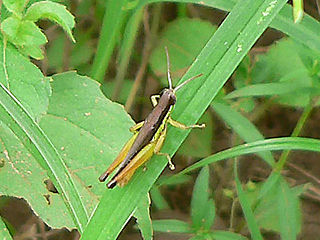
Spathosternum is a genus of grasshoppers in the family Acrididae: subfamily Spathosterninae, with species found in Africa, including Madagascar and tropical Asia.

Truxalis is a genus of grasshoppers in the family Acrididae, subfamily Acridinae and tribe Truxalini. Species can be found in: Africa, the Iberian peninsula, Asia minor through to Indo-China.
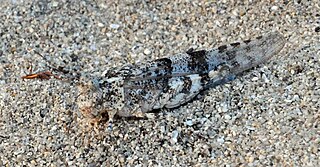
Sphingonotus is a genus of grasshoppers in the family Acrididae, subfamily Oedipodinae, found in Europe Africa, Asia and Australia.
The Euryphyminae are a subfamily of grasshoppers in the family Acrididae, based on the type genus Euryphymus and may be called "agile grasshoppers"; it was erected by Vitaly Michailovitsh Dirsh in 1956. Species have been recorded from parts of sub-Saharan Africa including Madagascar.
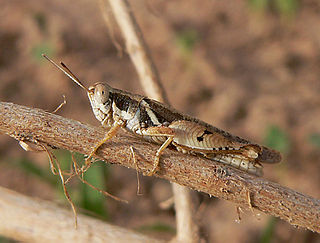
Cryptocatantops haemorrhoidalis is a species of grasshopper in the Cryptocatantops genus.
Cryptocatantops simlae is a species of grasshopper in the Cryptocatantops genus.
Cryptocatantops uvarovi is a species of grasshopper in the Cryptocatantops genus found in Somalia.












